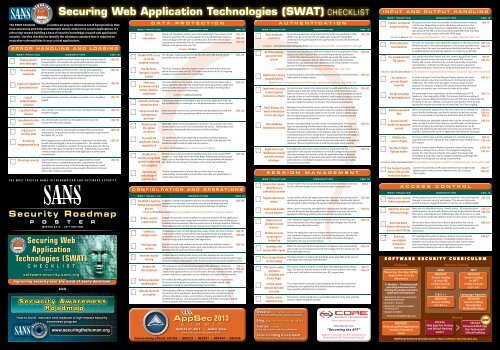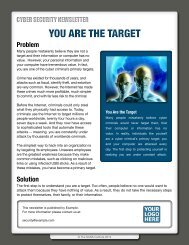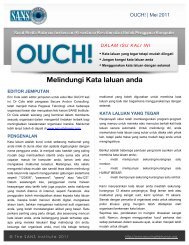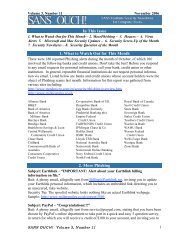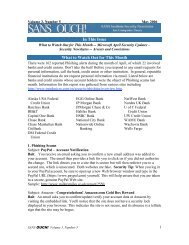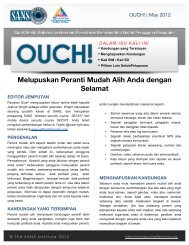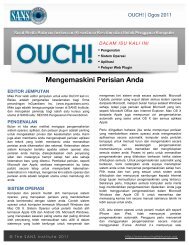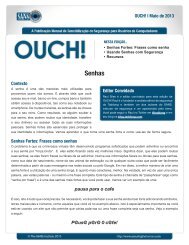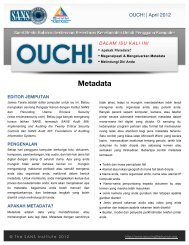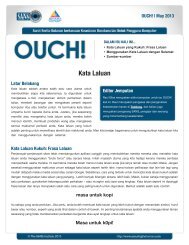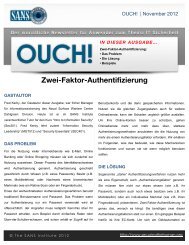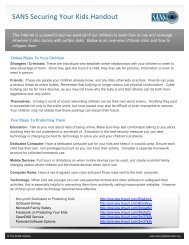Securing Web Application Technologies (SWAT) CHECKLIST
Securing Web Application Technologies (SWAT) CHECKLIST
Securing Web Application Technologies (SWAT) CHECKLIST
You also want an ePaper? Increase the reach of your titles
YUMPU automatically turns print PDFs into web optimized ePapers that Google loves.
<strong>Securing</strong> <strong>Web</strong> <strong>Application</strong> <strong>Technologies</strong> (<strong>SWAT</strong>) <strong>CHECKLIST</strong><br />
I N P U T AND OUTPU T HANDLING<br />
B EST P R ACT ICE<br />
DESC R I PTI O N<br />
CWE ID<br />
The <strong>SWAT</strong> Checklist<br />
provides an easy to reference set of best practices that<br />
raise awareness and help development teams create more secure applications. It’s<br />
a first step toward building a base of security knowledge around web application<br />
security. Use this checklist to identify the minimum standard that is required to<br />
neutralize vulnerabilities in your critical applications.<br />
E RROR HANDLING AND LOGGING<br />
B EST P R ACT ICE<br />
Display generic<br />
error messages<br />
No unhandled<br />
exceptions<br />
Suppress framework<br />
generated errors<br />
Log all<br />
authentication<br />
activities<br />
Log all privilege<br />
changes<br />
Log administrative<br />
activities<br />
Log access to<br />
sensitive data<br />
Do not log<br />
inappropriate data<br />
Store logs securely<br />
DESC R I PTI O N<br />
Error messages should not reveal details about the internal state of<br />
the application. For example, file system path and stack information<br />
should not be exposed to the user through error messages.<br />
Given the languages and frameworks in use for web application<br />
development, never allow an unhandled exception to occur. Error<br />
handlers should be configured to handle unexpected errors and<br />
gracefully return controlled output to the user.<br />
Your development framework or platform may generate default error<br />
messages. These should be suppressed or replaced with customized<br />
error messages as framework generated messages may reveal<br />
sensitive information to the user.<br />
Any authentication activities, whether successful or not, should be<br />
logged.<br />
Any activities or occasions where the user’s privilege level changes<br />
should be logged.<br />
Any administrative activities on the application or any of its<br />
components should be logged.<br />
Any access to sensitive data should be logged. This is particularly<br />
important for corporations that have to meet regulatory requirements<br />
like HIPAA, PCI, or SOX.<br />
While logging errors and auditing access is important, sensitive data<br />
should never be logged in an unencrypted form. For example, under<br />
HIPAA and PCI, it would be a violation to log sensitive data into the log<br />
itself unless the log is encrypted on the disk. Additionally, it can create<br />
a serious exposure point should the web application itself become<br />
compromised.<br />
Logs should be stored and maintained appropriately to avoid<br />
information loss or tampering by intruder. Log retention should<br />
also follow the rention policy set forth by the organization to meet<br />
regulatory requirements and provide enough information for foresic<br />
and incident response activities.<br />
CWE ID<br />
CWE-209<br />
CWE-391<br />
CWE-209<br />
CWE-778<br />
CWE-778<br />
CWE-778<br />
CWE-778<br />
CWE-532<br />
CWE-533<br />
THE MOST TRUST ED NAM E IN INFORM A T ION A N D S OFT WARE S ECURIT Y<br />
B EST P R ACT ICE<br />
Use SSL<br />
everywhere<br />
Disable HTTP access<br />
for all SSL<br />
enabled resources<br />
Use the Strict-<br />
Transport-Security<br />
header<br />
Store user<br />
passwords using a<br />
strong, iterative,<br />
salted hash<br />
Securely exchange<br />
encryption keys<br />
Set up secure key<br />
management<br />
processes<br />
Disable weak<br />
SSL ciphers<br />
on servers<br />
Use valid SSL<br />
certificates from a<br />
reputable CA<br />
Disable data<br />
caching using cache<br />
control headers and<br />
autocomplete<br />
Limit the use<br />
and storage of<br />
sensitive data<br />
D A T A<br />
PROTEC T I O N<br />
DESC R I PTI O N<br />
Ideally, SSL should be used for your entire application. If you have to limit<br />
where it’s used then SSL must be applied to any authentication pages as<br />
well as all pages after the user is authenticated. If sensitive information<br />
(e.g. personal information) can be submitted before authentication those<br />
features must also be sent over SSL.<br />
EXAMPLE: Firesheep<br />
For all pages requiring protection by SSL, the same URL should not be<br />
accessible via the non-SSL channel.<br />
The Strict-Transport-Security header ensures that the browser does not<br />
talk to the server over non-SSL. This helps reduce the risk of SSL stripping<br />
attacks as implemented by the sslsniff tool.<br />
User passwords must be stored using secure hashing techniques with a<br />
strong algorithm like SHA-256. Simply hashing the password a single time<br />
does not sufficiently protect the password. Use iterative hashing with a<br />
random salt to make the hash strong.<br />
EXAMPLE: LinkedIn password leak<br />
If encryption keys are exchanged or pre-set in your application then any<br />
key establishment or exchange must be performed over a secure channel.<br />
When keys are stored in your system they must be properly secured and<br />
only accessible to the appropriate staff on a need to know basis.<br />
Weak SSL ciphers must be disabled on all servers. For example, SSL v2 has<br />
known weaknesses and is not considered to be secure. Additionally, some<br />
ciphers are cryptographically weak and should be disabled.<br />
SSL certificates should be signed by a reputable certificate authority.<br />
The name on the certificate should match the FQDN of the website. The<br />
certificate itself should be valid and not expired.<br />
EXAMPLE: CA Compromise (http://en.wikipedia.org/wiki/DigiNotar)<br />
Browser data caching should be disabled using the cache control HTTP<br />
headers or meta tags within the HTML page. Additionally, sensitive input<br />
fields, such as the login form, should have the autocomplete=off setting in<br />
the HTML form to instruct the browser not to cache the credentials.<br />
Conduct an evaluation to ensure that sensitive data is not being<br />
unnecessarily transported or stored. Where possible, use tokenization to<br />
reduce data exposure risks.<br />
CWE ID<br />
CWE-311<br />
CWE-319<br />
CWE-523<br />
CWE-319<br />
CWE-257<br />
CWE-320<br />
CWE-524<br />
CONFIGUR A<br />
T I O N AND OPERA T I O N S<br />
B EST P R ACT ICE<br />
Don’t hardcode<br />
S ESSI O N MANAGEMEN T<br />
B EST P R ACT ICE<br />
Ensure that session<br />
identifiers are<br />
sufficiently random<br />
AUTHEN T ICAT I O N<br />
DESC R I PTI O N<br />
Never allow credentials to be stored directly within the application code. CWE-798<br />
While it can be convenient to test application code with hardcoded<br />
credentials<br />
credentials during development this significantly increases risk and should<br />
be avoided.<br />
EXAMPLE: Hard coded passwords in networking devices https://www.us-cert.gov/control_systems/pdf/ICSA-12-243-01.pdf<br />
Develop a strong<br />
password reset<br />
system<br />
Implement a strong<br />
password policy<br />
Implement account<br />
lockout against<br />
brute force attacks<br />
Don’t disclose too<br />
much information<br />
in error messages<br />
Store database<br />
credentials securely<br />
<strong>Application</strong>s and<br />
Middleware should<br />
run with minimal<br />
privileges<br />
Password reset systems are often the weakest link in an application. These<br />
systems are often based on the user answering personal questions to<br />
establish their identity and in turn resetthe password. The system needs<br />
to be based on questions that are both hard to guess and brute force.<br />
Additionally, any password reset option must not reveal whether or not an<br />
account is valid, preventing username harvesting.<br />
EXAMPLE: Sara Palin password hack (http://en.wikipedia.org/wiki/Sarah_Palin_email_hack)<br />
A password policy should be created and implemented so that passwords<br />
meet specific strength criteria.<br />
EXAMPLE: http://www.pcworld.com/article/128823/study_weak_passwords_really_do_help_hackers.html<br />
DESC R I PTI O N<br />
Session tokens must be generated by secure random functions and must<br />
be of a sufficient length so as to withstand analysis and prediction.<br />
CWE ID<br />
CWE-640<br />
Account lockout needs to be implemented to guard against brute forcing CWE-307<br />
attacks against both the authentication and password reset functionality.<br />
After serveral tries on a specific user account, the account should be locked for<br />
a period of time or until manually unlocked. Additionally, it is best to continue<br />
the same failure message indicating that the credentials are incorrect or the<br />
account is locked to prevent an attacker from harvesting usernames.<br />
Messages for authentication errors must be clear and, at the same time,<br />
be written so that sensitive information about the system is not disclosed.<br />
For example, error messages which reveal that the userid is valid but that<br />
the corresponsing password is incorrect confirms to an attacker that the<br />
account does exist on the system.<br />
Modern web applications usually consist of multiple layers. The business CWE-257<br />
logic tier (processing of information) often connects to the data tier<br />
(database). Connecting to the database, of course, requires authentication.<br />
The authentication credentials in the business logic tier must be stored in a<br />
centralized location that is locked down. Scattering credentials throughout<br />
the source code is not acceptable. Some development frameworks<br />
provide a centralized secure location for storing credentials to the backend<br />
database. These encrypted stores should be leveraged when possible.<br />
If an application becomes compromised it is important that the<br />
application itself and any middleware services be configured to run with<br />
minimal privileges. For instance, while the application layer or business<br />
layer needs the ability to read and write data to the underlying database,<br />
administrative credentials that grant access to other databases or tables<br />
should not be provided.<br />
CWE-521<br />
CWE-250<br />
CWE ID<br />
CWE-6<br />
Conduct contextual<br />
output encoding<br />
Prefer whitelists<br />
over blacklists<br />
Use parameterized<br />
SQL queries<br />
Use tokens to<br />
prevent forged<br />
requests<br />
Set the encoding<br />
for your application<br />
Validate uploaded<br />
files<br />
Use the nosniff<br />
header for uploaded<br />
content<br />
Use Content Security<br />
Policy (CSP) or X-XSS-<br />
Protection headers<br />
For each user input field, there should be validation on the input content.<br />
Whitelisting input is the preferred approach. Only accept data that meets<br />
a certain criteria. For input that needs more flexibility, blacklisting can also<br />
be applied where known bad input patterns or characters are blocked.<br />
In order to prevent Cross-Site Request Forgery attacks, you must<br />
embed a random value that is not known to third parties into the<br />
HTML form. This CSRF protection token must be unique to each<br />
request. This prevents a forged CSRF request from being submitted<br />
because the attacker does not know the value of the token.<br />
CWE-159<br />
CWE-144<br />
SQL queries should be crafted with user content passed into a bind CWE-89<br />
variable. Queries written this way are safe against SQL injection CWE-564<br />
attacks. SQL queries should not be created dynamically using string<br />
concatenation. Similarly, the SQL query string used in a bound or<br />
parameterized query should never be dynamically built from user input.<br />
EXAMPLE: Sony SQL injection Hack (http://www.infosecurity-magazine.com/view/27930/lulzsec-sony-pictures-hackers-were-school-chums)<br />
Use the X-Frame-<br />
Options header<br />
CWE-352<br />
For every page in your application set the encoding using HTTP CWE-172<br />
headers or meta tags within HTML. This ensures that the encoding of<br />
the page is always defined and that browser will not have to determine the<br />
encoding on its own. Setting a consistent encoding, like UTF-8, for your<br />
application reduces the overall risk of issues like Cross-Site Scripting.<br />
When accepting file uploads from the user make sure to validate the<br />
size of the file, the file type, and the file contents as well as ensuring<br />
that it is not possible to override the destination path for the file.<br />
When hosting user uploaded content which can be viewed by other<br />
users, use the X-Content-Type-Options: nosniff header so that browsers<br />
do not try to guess the data type. Sometimes the browser can be<br />
tricked into displaying the data type incorrectly (e.g. showing a GIF file<br />
as HTML). Always let the server or application determine the data type.<br />
Use the X-Frame-Options header to prevent content from being<br />
loaded by a foreign site in a frame. This mitigates Clickjacking<br />
attacks. For older browsers that do not support this header add<br />
framebusting Javascript code to mitigate Clickjacking (although this<br />
method is not foolproof and can be circumvented).<br />
Content Security Policy (CSP) and X-XSS-Protection headers help<br />
defend against many common reflected Cross-Site Scripting<br />
(XSS) attacks.<br />
CWE-434<br />
CWE-616<br />
CWE-22<br />
CWE-430<br />
CAPEC-103<br />
CWE-693<br />
EXAMPLE: Flash camera and mic hack (http://jeremiahgrossman.blogspot.com/2008/10/clickjacking-web-pages-can-see-and-hear.html)<br />
B EST P R ACT ICE<br />
All output functions must contextually encode data before sending<br />
it to the user. Depending on where the output will end up in the<br />
HTML page, the output must be encoded differently. For example,<br />
data placed in the URL context must be encoded differently than data<br />
placed in JavaScript context within the HTML page.<br />
EXAMPLE: Resource: https://www.owasp.org/index.php/XSS_(Cross_Site_Scripting)_Prevention_Cheat_Sheet<br />
Validate the<br />
source of input<br />
The source of the input must be validated. For example, if input is<br />
expected from a POST request do not accept the input variable from a<br />
GET request.<br />
A CCESS CON TROL<br />
DESC R I PTI O N<br />
CWE-79<br />
CWE-20<br />
CWE-346<br />
CWE-79<br />
CWE-692<br />
CWE ID<br />
Security Roadmap<br />
P O S T E R<br />
W I N T E R 2 0 1 3 – 2 3 R D E D I T I O N<br />
<strong>Securing</strong> <strong>Web</strong><br />
<strong>Application</strong><br />
<strong>Technologies</strong> (<strong>SWAT</strong>)<br />
C H E C K L I S T<br />
Version 1.0<br />
software-security.sans.org<br />
Ingraining security into the mind of every developer.<br />
A N D<br />
B EST P R ACT ICE<br />
Establish a rigorous<br />
change management<br />
process<br />
A rigorous change management process must be maintained during<br />
operations. For example, new releases should only be deployed after<br />
proper testing and associated documentation has been completed.<br />
EXAMPLE: RBS production outage (http://www.computing.co.uk/ctg/analysis/2186972/rbs-wrong-rbs-manager)<br />
Define security<br />
requirements<br />
Conduct a<br />
design review<br />
Perform code<br />
reviews<br />
Perform security<br />
testing<br />
Harden the<br />
infrastructure<br />
Define an incident<br />
handling plan<br />
Educate the team<br />
on security<br />
DESC R I PTI O N<br />
Engage the business owner to define security requirements for the application.<br />
This includes items that range from the whitelist validation rules all the way to<br />
nonfunctional requirements like the performance of the login function. Defining<br />
these requirements up front ensures that security is baked into the system.<br />
Integrating security into the design phase saves money and time. Conduct<br />
a risk review with security professionals and threat model the application<br />
to identify key risks. The helps you integrate appropriate countermeasures<br />
into the design and architecture of the application.<br />
Security focused code reviews can be one of the most effective ways to<br />
find security bugs. Regularly review your code looking for common issues<br />
like SQL Injection and Cross-Site Scripting.<br />
An incident handling plan should be drafted and tested on a regular basis.<br />
The contact list of people to involve in a security incident related to the<br />
application should be well defined and kept up to date.<br />
CWE-439<br />
CWE-701<br />
CWE-656<br />
CWE-702<br />
Conduct security testing both during and after development to ensure the<br />
application meets security standards. Testing should also be conducted after major<br />
releases to ensure vulnerabilities did not get introduced during the update process.<br />
All components of infrastructure that support the application should be CWE-15<br />
configured according to security best practices and hardening guidelines. In CWE-656<br />
a typical web application this can include routers, firewalls, network switches, operating<br />
systems, web servers, application servers, databases, and application frameworks.<br />
Training helps define a common language that the team can use to improve<br />
the security of the application. Education should not be confined solely to<br />
software developers, testers, and architects. Anyone associated with the<br />
development process, such as business analysts and project managers, should<br />
all have periodic software security awareness training.<br />
AppSec 2013<br />
S U M M I T<br />
April 22-27, 2013 | Austin, Texas<br />
www.sans.org/event/appsec-2013<br />
Courses being offered: SEC542 • DEV522 • DEV541 • DEV544 • DEV536<br />
CWE ID<br />
Regenerate session<br />
tokens<br />
Implement an idle<br />
session timeout<br />
Implement an<br />
absolute session<br />
timeout<br />
Destroy sessions<br />
at any sign of<br />
tampering<br />
Invalidate the<br />
session after logout<br />
Place a logout button<br />
on every page<br />
Use secure cookie<br />
attributes<br />
(i.e. HttpOnly and<br />
Secure flags)<br />
Set the cookie<br />
domain and path<br />
correctly<br />
Set the cookie<br />
expiration time<br />
<strong>Web</strong>site: http://software-security.sans.org<br />
Free resources, white papers, webcasts, and more<br />
Blog: http://software-security.sans.org/blog<br />
Twitter: @sansappsec<br />
Latest news, promos, and other information<br />
Secure Coding Assessment:<br />
http://software-security.sans.org/courses/assessment<br />
Session tokens should be regenerated when the user authenticates to the CWE-384<br />
application and when the user privilege level changes. Additionally, should<br />
the encryption status change, the session token should always be regenerated.<br />
When a user is not active, the application should automatically log the<br />
user out. Be aware that Ajax applications may make recurring calls to the<br />
application effectively resetting the timeout counter automatically.<br />
Users should be logged out after an extensive amount of time (e.g. 4-8<br />
hours) has passed since they logged in. This helps mitigate the risk of an<br />
attacker using a hijacked session.<br />
Unless the application requires multiple simultaneous sessions for a single<br />
user, implement features to detect session cloning attempts. Should any<br />
sign of session cloning be detected, the session should be destroyed,<br />
forcing the real user to reauthenticate.<br />
When the user logs out of the application the session and corresponding<br />
data on the server must be destroyed. This ensures that the session can not<br />
be accidentially revived.<br />
The logout button or logout link should be easily accessible to the user on<br />
every page after they have authenticated.<br />
The session cookie should be set with both the HttpOnly and the Secure<br />
flags. This ensures that the session id will not be accessible to client-side<br />
scripts and it will only be transmitted over SSL, respectively.<br />
The cookie domain and path scope should be set to the most restrictive<br />
settings for your application. Any wildcard domain scoped cookie must<br />
have a good justification for its existence.<br />
The session cookie should have a reasonable expiration time. Non-expiring<br />
session cookies should be avoided.<br />
www.coresecurity.com<br />
WHITEPAPER TITLE<br />
“Becoming the APT”<br />
CWE-613<br />
CWE-613<br />
CWE-613<br />
CWE-79<br />
CWE-614<br />
http://coresecurity.com/files/attachments/<br />
Becoming-the-APT-Rebranded-Final.pdf<br />
Apply access controls<br />
checks consistently<br />
Apply the principle<br />
of least privilege<br />
Don’t use direct<br />
object references for<br />
access control checks<br />
Don’t use<br />
unvalidated<br />
forwards or<br />
redirects<br />
Always apply the principle of complete mediation, forcing all requests<br />
through a common security “gate keeper.” This ensures that access<br />
control checks are triggered whether or not the user is authenticated.<br />
Make use of a Mandatory Access Control system. All access decisions CWE-272<br />
will be based on the principle of least privilege. If not explicitly allowed CWE-250<br />
then access should be denied. Additionally, after an account is created,<br />
rights must be specifically added to that account to grant access to resources.<br />
Do not allow direct references to files or parameters that can be<br />
manipulated to grant excessive access. Access control decisions must<br />
be based on the authenticed user identity and trusted server side<br />
information.<br />
An unvalidated forward can allow an attacker to access private<br />
content without authentication. Unvalidated redirects allow an<br />
attacker to lure victims into visiting malicious sites. Prevent these<br />
from occurring by conducting the appropriate access controls<br />
checks before sending the user to the given location.<br />
SOFTWARE SECURITY CURRICUL U M<br />
Defense<br />
<strong>Securing</strong> the App (STA)<br />
<strong>Application</strong> Security<br />
Awareness<br />
11 Modules – 10 minutes each<br />
providing awareness-level<br />
training for people involved in<br />
application development.<br />
• <strong>Application</strong> Security training for<br />
development teams<br />
• Duration = 2 hours<br />
• Delivered = Computer-Based<br />
Training (CBT)<br />
• Quizzes included<br />
www.securingtheapp.org<br />
DEV522<br />
Defending <strong>Web</strong> <strong>Application</strong>s<br />
Security Essentials<br />
GWEB<br />
Secure Coding<br />
JAVA<br />
DEV541<br />
Secure Coding<br />
in Java/JEE<br />
(4-Day Course)<br />
GSSP-JAVA<br />
C & C++<br />
DEV543<br />
Secure Coding<br />
in C & C++<br />
.NET<br />
DEV544<br />
Secure Coding<br />
in .NET<br />
(4-Day Course)<br />
GSSP-.NET<br />
Additional Software Security Courses http://software-security.sans.org<br />
CWE-284<br />
CWE-284<br />
CWE-601<br />
Language Agnostic<br />
DEV536<br />
Secure Coding:<br />
Developing<br />
Defensible Apps<br />
Attack<br />
SEC542<br />
SEC642<br />
<strong>Web</strong> App Pen Testing<br />
Advanced <strong>Web</strong> App<br />
and Ethical Hacking<br />
Pen Testing and<br />
GWAPT<br />
Ethical Hacking<br />
New!


